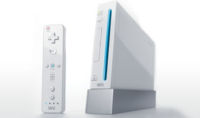Wii

| |

| |
| Wii | |
| Manufacturer | Nintendo |
| Type | Home Console |
| Generation | Seventh |
| Lifespan | 2006 - 2013 |
| CPU | IBM PowerPC-based "Broadway" |
| GPU | ATI "Hollywood" |
| Media | 12 cm Wii Optical Disc, 8 cm GameCube disc |
| Storage | 512MB Internal flash memory, Gamecube memory card, Secure Digital Card |
| Controllers | Four wireless, Four Gamecube ports. |
| Connectivity | Wi-Fi Blue Tooth USB 2.0 LAN Adapter |
| Online Service | Nintendo Wi-Fi Connection WiiConnect24 Wii Shop Channel (Virtual Console, WiiWare, Wii Channels) |
| Release Date | JP December 2, 2006 US November 19, 2006 EU December 8, 2006 AU December 7, 2006 KO April 26, 2008 |
| Units Sold | 101.63 million |
| Top Game | Wii Sports |
| Compatibility | GameCube |
| Predecessor | GameCube |
| Successor | Wii U |
The Wii' (pronounced "We") was Nintendo's fifth home console. Formerly known by the codename of "The Revolution", the Wii had a unique motion-sensing controller. Through this system, Nintendo attempted to target a larger demographic by having easy-to-use controls. In Japan, the system was discontinued in 2013, when it was succeeded by the Wii U. In America and Europe, the original system was discontinued in 2011, and other versions of the system were produced until 2017.
Features
Wii Remote
One of its most unique features its controller, known as the Wii Remote. The Wii Remote was designed to look similar to a TV Remote in order to attract users who don't normally play video games. It featured an attachment known as the Nunchuk Controller. The two could be used together for motion controls, but they also had buttons, which could be utilized like normal controllers.
There were also several alternate accessories, such as the Classic Controller, which was designed to function more like a traditional video game controller. There was also an attachment called the MotionPlus, which was made available in 2009 and used gyroscopes to enhance the controller's motion sensing capabilities.
Wii Channels
The Wii's interface was designed around different channels that could be selected by the player. The primary ones were the Disc Channel (for playing whatever disc is inserted in the system), Mii Channel, Photo Channel, Wii Shop Channel, Forecast Channel, and News Channel. Later channels included the Internet Channel and the Everybody Votes Channel.
Through the Mii Channel, players could create a number of virtual avatars known as Miis. This was the introduction of Miis, which would continue to be used in future Nintendo systems and could often play some roles within games themselves.
Compatibility
The Nintendo Wii was backwards compatible with Gamecube games. To play Gamecube games, the player must use a Gamecube controller and Gamecube memory cards. Most of the Gamecube's peripherals also worked with the Wii. The exceptions are that that the GameCube modem adapter, broadband adapter, Game Boy Player, AV cable, and AC adapter do not work with the Wii.
The Nintendo DS is able to wirelessly connect to the Wii, similar to the connectivity feature the Game Boy Advance and Gamecube had. Games such as Pokémon Battle Revolution have made use of this feature. Select demos for DS games could be downloaded through the Nintendo Channel. Miis can also be transferred to certain DS games.
Online Connectivity
The Wii was able to connect to the internet through Nintendo's Wi-Fi service. Similar to the DS, a friend code system is used. However, only one friend code was used per system.
The WiiConnect24 service was closed down in June 2013 due to the release of the Wii U, and the Nintendo Wi-Fi Connection in general was shut down in May 2014. The Wii Shop Channel (including the Virtual Console service) remained active until it was shut down in January 2019.
Other Features
The Wii features the ability to limit the games that can be played on the Wii. Each region's Wii uses the rating system relevant to that region (North America uses ESRB, Japan uses CERO, Europe uses PEGI, ect.). If a game is of an inappropriate rating, an override code is needed to play it. This only works on Wii and Virtual Console games; it does not affect Gamecube games.
Several streaming services, such as Netflix, Hulu and Amazon Prime, became available for the Wii over time.
Other Versions
A version known as the Wii Family Edition was made available in 2011 in North America, Europe and Australia only. It was similar to the original edition, but it was made to sit horizontally only, and it lacked reverse compatibility with Gamecube games. This version was discontinued in 2013 in North America and Europe, although it remained in production in Australia in 2017.
A smaller model called the Wii Mini was originally made available in Canada in 2012, and it was released in North America and Europe in 2013. This version also lacked the compatibility with Gamecube games and also lacked several other features such as compatibility with SD Cards and online connectivity. This version remained in production until its cancellation in 2017.
See Also
Games
| Nintendo Systems |
|---|
| NES - Super NES - Nintendo 64 - GameCube - Wii - Wii U - Switch Game Boy - Game Boy Color - Game Boy Advance - Nintendo DS (DSi) - 3DS (New 3DS) Arcade - Color TV Game - Game & Watch - Virtual Boy |